Finnish sniper Simo Häyhä shot and killed at least 540 Soviet soldiers in the Winter War that lasted just 100 days. To this day, he is considered the most effective shooter in history. What is the secret of his successes? Did he dream of killed enemies?
Simo Häyhä was a simple boy from the small village of Kiiskinen in Karelia. He was born in 1905, when Finland was still part of the Russian Empire. His family lived off farming, supporting household finances with “gifts of the forest” - for example, chopping wood for sale, hunting and selling fox skins. Häyhä only completed four years of primary school, and although he had good grades, he was not eager to continue his studies. He knew that poor parents needed his hands to work on the farm, so there was no question of continuing education.
Simo had four brothers and three sisters. One of them - Antii - died in the liberation war of 1918, and another - Tuomas - died as a result of a sunstroke. So the older parents on the farm were helped by the other three sons:Juhana, Matti and Simo, and their daughters - Katri, Mari and Hilja. According to tradition, the eldest son's wife ruled in the kitchen. It was Hilda, Juhana's wife.
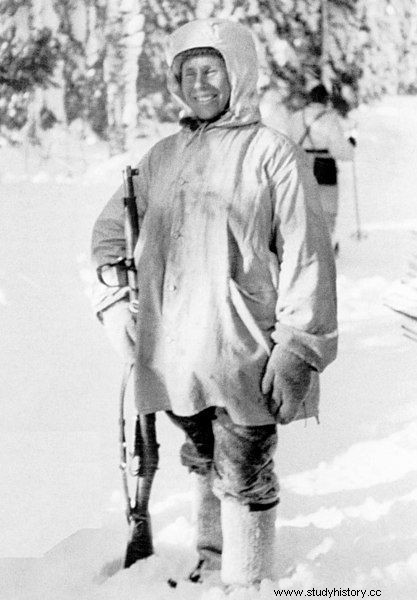
Simo Häyhä was first a great… hunter
Simo, like his brothers and sisters, had his hands full. He did the hardest and least pleasant jobs:he cleaned in a barn, pigsty, stables and worked in the field. But most of all - which later influenced his life - he went hunting. First with my father, an experienced hunter, and then alone. He felt at home in the forest:he learned to read tracks, to approach game unnoticed, to mask himself and, above all, to shoot accurately. Simo, like most Finns, was good at skiing and also used them for hunting.
Independent Finland
In 1918, after the end of World War I, Finland - like Poland - gained independence. However, the country was poor, economically underdeveloped and struggled with all the problems of the "childhood period", also known to us. One of the problems was the lack of money for the military. To strengthen the country's defense, the Citizen's Guard, a Finnish self-defense force, was established to support the regular army in the event of an enemy attack. And there could be only one enemy, because by the side - on the ruins of tsarist Russia - a new, aggressive neighbor - Soviet Russia - grew up.
The Finnish government was aware of the threat from the east and decided to base its defense doctrine not on tanks and guns, but above all on general military training. It included both men and women.
Simo joined the Civic Guard in 1922, and then, in the years 1925-1927, he completed his essential military service in ... cyclists' units. Its potential was quickly noticed in the army and the Civil Guard. Won several shooting competitions, won many awards. Importantly, he not only shot accurately, but also was able to reload the gun very quickly and assemble the shot. He was also fit, he had a good condition and he was able to endure many hours of field activities, even in the most difficult conditions, e.g. frost, deep snow. He was small (he was 160 cm), which made it easier for him to stealthily approach the target and disguise himself. Soon Finland was about to use his innate talent and acquired skills.

The Ribbentrop-Molotov Pact. Stalin and Ribbentrop. Moscow August 23, 1939
Due to his service in the Civic Guard and his love of shooting and hunting, Simo had his own rifle at home. It was a Russian M28 / 30 Pystrykorva modified in Finland. In peacetime, Häyha honed his shooting skills by hunting and participating in competitions. He also went skiing and playing pesapallo - the Finnish version of baseball. In 1939, Simo, then 34 years old and a mature man, was drafted into the army. Finland was getting ready for war…
The Soviet Union, after the occupation of Poland together with Germany in September 1939, had further political and territorial claims. According to the secret protocol of the Ribbentrop-Molotov Pact, the Baltic states and Finland were to fall within the reach of Soviet influence. The governments of Lithuania, Latvia and Estonia succumbed to Stalin's demands and became dependent territories. Finland did not want to submit to its powerful neighbor and refused to hand over the border areas and lease the Hanko peninsula to the Soviets for 30 years. On November 26, 1939, the "Mainila incident" took place - Soviet artillery shelled a village on the territory of the USSR and accused the Finns of it. Stalin demanded an apology and the withdrawal of Finnish troops from the border into the territory of the country. Finland's refusal was a pretext to start the war.
The Soviets are coming. Finland is fighting!
On November 30, the Soviet forces in the strength of 23 divisions entered the territory of Finland. The offensive was arduous from the very beginning. The defenders were favored by natural conditions and fortifications prepared in advance. E.g. the Mannerheim Line was located on the Karelian Isthmus, through which was the shortest way into the country and to Helsinki. It was a strongly fortified defensive line equipped with concrete bunkers and earth fortifications. It allowed for long-term defense, but also allowed the Finns to withdraw to the next sections and continue the fight. It was on the Karelian Isthmus that it turned out that the Red Army is a colossus on clay legs. The soldiers were poorly trained, the equipment broke down, and the officer cadre consisted of under-educated dilettantes, because experienced officers had swept the Stalinist purges of 1937–1939.
The Soviet offensive progressed slowly in other sections of the front as well. The Finnish command even decided to launch local counterattacks and some of them were successful! It was surprising for both sides. Red Army troops, which had multiple advantages over the Finns and had almost unlimited ammunition, dug in, retreated, and very often panicked and escaped. They lost a lot of people and equipment, including tanks that were taken over by the Finns, repaired and manned by their crews. A characteristic element of this conflict was that small Finnish troops first surrounded and then crushed Soviet units many times more numerous than them! In the following weeks of the Winter War, the creation of the so-called motti (or cauldrons), has become a Finnish specialty and an effective method of fighting the powerful aggressor.
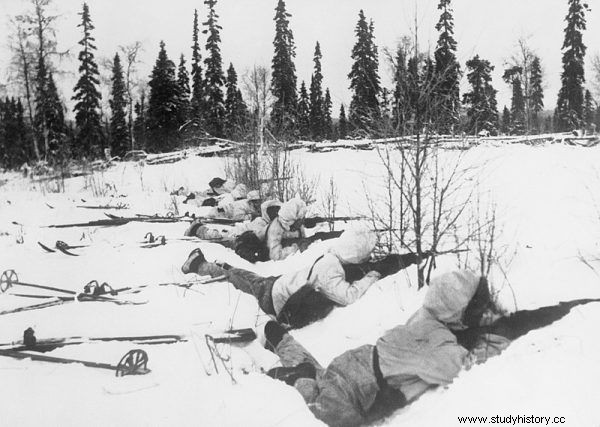
Finnish skiers in defensive positions
Not only was the Finnish artillery devastating in the Soviet ranks, but also - deadly - Jegers from the Finnish Civil Guard. They moved quickly and quietly (on skis or snowshoes), thanks to the white camouflage suits they were invisible in the snow, and unlike the Russians - they shot accurately. During this period, there were very few white suits in the Red Army. Apparently, the Kremlin recognized that the Finns would be frightened by thousands of Soviet soldiers wading through the snow to their starting positions for the attack. The Finns did not get scared and took advantage of favorable circumstances, eliminating entire battalions and regiments. The Russians lost about 300,000 soldiers in the Winter War:killed, wounded and missing. The losses of the Finns amounted to 70,000.
Simo Häyha - The White Death
Among the defenders of Finland, the "genius of the rifle" - Simo Häyha - soon appeared in the defense section on the Kollaa River line. Already in the first days of the war, he received permission from the command to act independently. He was exempted from guards and "garrison" activities, he did not participate in collections and briefings. He would go out into the field at night, take the chosen position, mask himself and ... wait. When it was light and a Soviet soldier appeared in his sight, his fate was doomed. Häyha was not perfect and didn't always hit the first try. Sometimes he had to "correct" a second time. But it was rare.
Surprisingly, Häyha did not use any sophisticated shooting or sniper techniques. He used his "private" M28 / 30 rifle without optics (he believed that optics forced him to raise his head higher, making it more visible), he fired quite often, not once or twice a day. He usually took 60 rounds for a rifle on a "patrol". He also used the Suomi submachine gun and the Lahti L-35 short pistol in situations when the enemy was approaching his position. According to the findings of Häyha's biographers, he killed about 250 Soviet soldiers with a submachine gun, but - according to the rules of the game - they are not included in his sniper output.
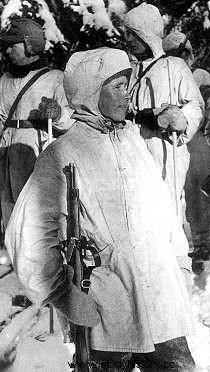
Finnish Marksman Simo Häyhä
Häyh's combat methods are likely to disappoint anyone who watched the sniper movies:Simo did not climb trees, shoot enemies in the head, and fail to distinguish between better and worse targets. His preparations for the fight were limited to compacting the snow with a shovel on the stand so that it would not be disturbed by the blast of a shot. In addition, he wrapped the rifle with white gauze or bandage so that the weapon was not visible in the snow. During the fight, he did not have any dilemmas, hesitations, thinking, taking his finger off the trigger - he just shot. During 98 days of the Winter War, he "eliminated" 542 Soviet soldiers. At least that was considered documented hits.
One of his first successes was the neutralization of a Soviet sniper who had previously killed three Finnish platoon commanders and a non-commissioned officer sent to replace them. Häyhä took the order to eliminate the enemy and went to the section where the enemy was "hunting". That day, Simo had to show incredible patience and endurance, because he was lying motionless in the snow all day, at a temperature that dropped to - 20 degrees.
When all indications were that the Soviet sniper would escape that day, he was betrayed by a flash of a ray of sunlight reflected in optical instruments. This allowed the Sim to aim the rifle at the likely hiding place of the Soviet shooter. Häyha assumed that the Russian considered his "work" on that day finished and decided to leave his post. But he tilted his head to take one last look at the foreground, and then a bullet from little Fin's rifle hit him. The Russian was hit on the cheek. In this case, the amendment was not needed. Häyha's skills are evidenced by the fact that he eliminated a total of five Soviet snipers - soldiers who were exceptionally well prepared for combat and, above all, able to mask themselves perfectly. One of the sharpshooters Häyhä "took" from a distance of 450 meters.
The Russians hunt the "White Death"
In the days and weeks that followed, Simo was still lucky. It can be assumed that on average he killed five Russians a day. There were days when he "scored" 10 or 15 hits, but also days when there were no successes. Häyhä did not mark the dead on the rifle butt, nor did he keep a hit book. If a soldier with such a notebook or a rifle with incisions fell into the hands of the Soviets, he would certainly face torture and death. Häyhä may have taken this into account and acted so that if he fell into the hands of the Soviets, they would consider him a regular line soldier, not a formidable sniper.
The Russians already knew that there was an excellent Finnish sniper on the Kollaa episode and gave him the nickname "White Death". They probably did not know his name yet and did not know what he looked like. However, they did everything to neutralize it. In the sections where Häyhä operated, fire attacks in the form of cannon and mortar fire were often directed, and the air force was called for help to bomb the indicated areas.
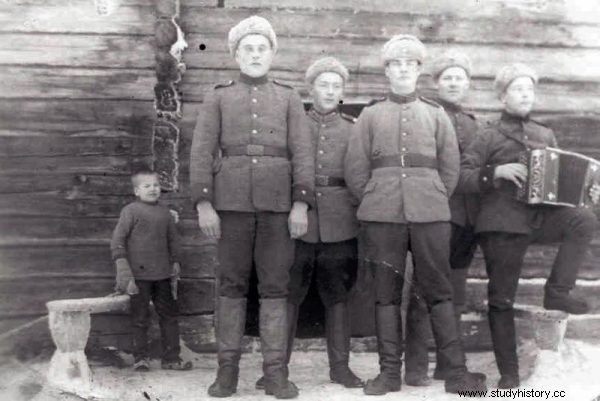
Finnish soldiers
However, Simo was lucky, he hid well and at the right moment left his position, because the Soviet missiles and bombs hit the void. Only in one case did a fragment tear the cloak on his back, causing a slight wound. However, the "White Death" quickly returned to the line to continue his mission, and he faced more and more difficult tasks.
One day I got a message from the headquarters that I should go to a section of the 5th company and destroy the Forward Observer's post where the artillery periscope had been spotted. I only had two or three shots at the periscope before the Russians started firing at us with heavy artillery. Debris, tree branches and ash flew around us, but somehow we survived. However, it forced us to stop the task and this time the periscope was not destroyed. Later I went back to that episode but now I have approached from a different angle. The artillery was firing in a different direction, so I managed to fire and destroy the periscope. The Soviets were extremely furious with the loss of a precious periscope
- recalled Simo Häyhä, who in this case eliminated not only the observer but also six other soldiers in the post.
On December 25, he recorded a great success - 25 hits. He had an exceptionally good streak during the holiday season, eliminating 51 Russians in three days. At the end of the war, he worked in a duet with the observer, Corporal Malmi. One day they sneaked to the rear of the Russians and approached their positions within 150 meters. On that day, Häyhä shot 19 enemy soldiers. By the end of the day, they hadn't figured out who was shooting at them and from what direction the shots were fired.
The outskirts of the Kollaa River, where Häyhä fought, were not broken until the end of the war. In this area, the 12th Infantry Division detained five Soviet divisions. However, in other sections of the front, the invaders finally used their advantage in terms of quantity and equipment, and at the end of February 1940 they broke deep into Finnish territory. This forced the Finnish government to start peace talks. That was also the end of Simo Häyha's streak and his shooting career.
He carried the wolf a few times…
On March 5 and 6, 1940, Simo took part in heavy fighting to maintain his position in the Ulismaa forest in the Kollaa area. The battle was fought at the shortest distance, even face to face, and the advancing Russians had a huge advantage in numbers. In this situation, the skills of a sharpshooter were not useful and Simo fought like a regular footman, firing a submachine gun. He shot about 40 Russians on March 6, but his destiny finally reached him. Around 14 was hit in the cheek by a short-range Sighting Missile.
I only heard a muffled sound and knew immediately that I was hit. I began to see a bright tunnel coming in, out, sliding back and forth
Simo recalled in a letter to his friend. The bullet ripped apart and caused severe wounds to the face and head. The colleagues from the detachment, who took him out of the battlefield on a sled, were sure that Simo would not survive. One version says that his body was already lying on a pile of corpses, but someone noticed Häyha's shoe and pulled it from under the bodies of his fallen colleagues. Simo regained consciousness on March 13 in the hospital. On the same day, Finland signed an armistice with the USSR and thus the Winter War ended.
Doctors fought for Häyha's life for a long time. For four months, he ate only through a tube, during which time doctors partially reconstructed his jaw. The maxillary bone was reconstructed by taking a 10 cm long bone segment from its hip. In total, he underwent 26 operations. The left side of his face, from ear to chin, was severely disfigured and he suffered from gunshot ailments for the rest of his life. Häyhä was demobilized and left the hospital in May 1941.
From June 1941, Finland was at war with the USSR again, this time supporting the Germans who attacked the Soviets as part of Operation Barbarossa. This conflict is known in Finland as the "Continuation War". The Finns, despite their initial successes and regaining their lost lands, eventually lost this war as well. Simo wanted to participate and volunteered, but due to his severe injuries, he was refused permission. His other skills were used and hired in the army as a classifier of horses destined for the front.
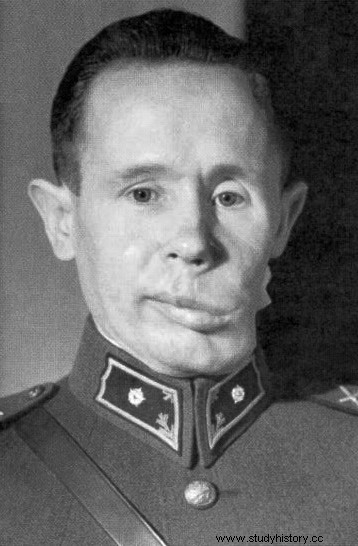
Simo Häyhä in the 1940s
After the war, Häyhä returned to farming, horse breeding and hunting. He was extremely secretive and modest. He reluctantly talked about his sniping accomplishments and protected his privacy. He never got married, but he was not lonely because his colleagues always remembered him - the comrades-in-arms from Kollaa and the large family.
Military historians and lecturers in shooting tactics tried to persuade him to confide. Two Finnish authors managed to extract some memories from it, resulting in two books. Thanks to them, Simo Häyhä became widely known not only in Finland but also all over the world. He died on April 1, 2002 in Hamin at the age of 96. He was buried in the church cemetery in Ruokolahti, Karelia. He always commented on his achievements very modestly. - I did what I was told - the best I could - is one of his most famous statements.
It is worth noting that before the Winter War, Simo Häyhä lived a banal and rather boring life as a farmer and hunter. He "scored" his 542 hits in 98 days. After the war, he returned to normal life and did nothing "interesting". Three months of the war marked his entire life. Today, the name of Simo Häyhä is known all over the world, and his nickname "White Death" is associated even by people who are not interested in history or military.
